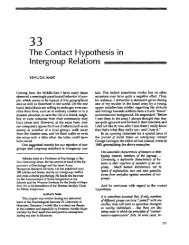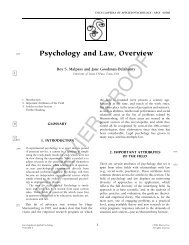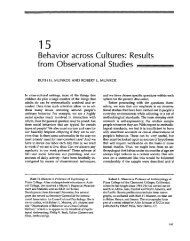Culture shock due to contact with unfamiliar cultures.
Culture shock due to contact with unfamiliar cultures.
Culture shock due to contact with unfamiliar cultures.
Create successful ePaper yourself
Turn your PDF publications into a flip-book with our unique Google optimized e-Paper software.
Online Readings in Psychology and <strong>Culture</strong>, Unit 15, Chapter 8http://www.ac.wwu.edu/%7Eculture/Bochner.htmsettings (Furnham & Bochner, 1986).The behavioural dimension is sometimes further divided in<strong>to</strong> three sub-categories: InstrumentalAdjustment, defined as the ability <strong>to</strong> navigate through the new environment. Examples of items include"I know where <strong>to</strong> shop for what I need." Interaction Adjustment, defined as casual interactions <strong>with</strong>host members "When I experienced unsatisfac<strong>to</strong>ry service, I did something about it; I have no difficultyin asking strangers for directions". And Relational Adjustment, defined as maintaining non-trivialfriendships and social networks <strong>with</strong> host members "I made friends <strong>with</strong> people of different ethnicbackgrounds." We have also developed a scale that measures Host-Language Proficiency, found <strong>to</strong> be agood index of behavioural adjustment.The cognitive dimension can also be regarded as having three distinct components: Interest in Other<strong>Culture</strong>s "When I meet people different from me, I want <strong>to</strong> learn more about them"; Tolerance forCultural Differences "When I meet people from other <strong>cultures</strong> I tend <strong>to</strong> feel judgmental about theirdifferences"; and Positive Attitudes Toward New or Unusual Cultural Environments "I believe I canlive a fulfilling life in another culture".Over the years, the author has been measuring the cognitive dimension of ethnic or cultural identity <strong>with</strong>the I Am Test, which consists of a sheet of paper listing ten incomplete statements beginning <strong>with</strong> "Iam.....". This measure is sensitive <strong>to</strong> whether participants are mono-cultural <strong>with</strong> respect <strong>to</strong> their new ororiginal culture, marginal <strong>with</strong> respect <strong>to</strong> both, or bi-cultural or culturally hyphenated individuals (e.g.Chinese-Australians). The procedure has its theoretical basis in Stephen Bochner's (1981)Mediating-Person Model. We also sometimes use a one-item test in which we simply ask people <strong>to</strong>write down what ethnic group they belong <strong>to</strong>. Colleen Ward and her colleagues have explored identityby conventional questionnaire items that measure how individuals perceive and relate <strong>to</strong> their owncultural groups and <strong>to</strong> members of other groups.Affective Adjustment is usually measured by means of scales adapted from the clinical literature <strong>to</strong> gaugethe amount of stress and physical and mental ill health the sojourners experience, or in positive terms,the extent of emotional well-being and satisfaction. Sub-scales include measures of anxiety, confusion,low self-esteem, homesickness, and a sense of helplessness. Subjective estimates of health are also oftenincluded, using questionnaires such as the General Health Questionnaire.ConclusionLet me conclude by commenting about the relationship between the A, B, and C elements of the model.In our book we regard each of the components as influencing and being influenced by the other twoelements. Technically, this can be described as a continuous feedback cycle reverberating among thethree components. In other words, what we feel will affect what we do and think, and vice versa cubed.And because there is no direct research regarding the relative importance of these three processes, the A,B, and C components have been accorded equal status by default. However I tend <strong>to</strong> the view, which isnot necessarily shared by my co-authors, that the primary determinants of culture <strong>shock</strong> as a negativereaction, and cross-cultural adaptation as a positive response, are in the behavioural domain. I believethat affective (emotional) responses are essentially retrospective evaluations of inter-cultural experiences,that is, behavioural episodes, which can range from the aversive <strong>to</strong> the highly satisfac<strong>to</strong>ry. And I assume8 of 10 3/19/06 5:38 PM







